tow FIAT PUNTO 2012 Owner handbook (in English)
[x] Cancel search | Manufacturer: FIAT, Model Year: 2012, Model line: PUNTO, Model: FIAT PUNTO 2012Pages: 219, PDF Size: 9.58 MB
Page 167 of 219
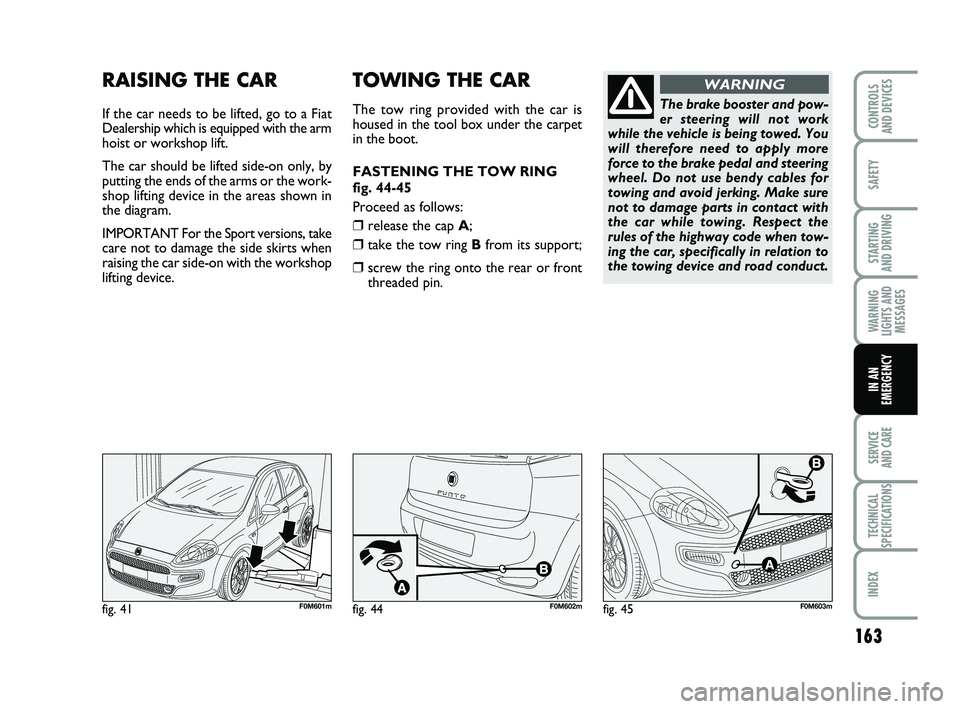
163
SAFETY
STARTING
AND DRIVING
WARNING
LIGHTS AND MESSAGES
SERVICE
AND CARE
TECHNICAL
SPECIFICATIONS
INDEX
CONTROLS
AND DEVICES
IN AN
EMERGENCY
fig. 41F0M601m
RAISING THE CAR
If the car needs to be lifted, go to a Fiat
Dealership which is equipped with the arm
hoist or workshop lift.
The car should be lifted side-on only, by
putting the ends of the arms or the work-
shop lifting device in the areas shown in
the diagram.
IMPORTANT For the Sport versions, take
care not to damage the side skirts when
raising the car side-on with the workshop
lifting device.
TOWING THE CAR
The tow ring provided with the car is
housed in the tool box under the carpet
in the boot.
FASTENING THE TOW RING
fig. 44-45
Proceed as follows:
❒release the cap A;
❒take the tow ring Bfrom its support;
❒screw the ring onto the rear or front
threaded pin.
The brake booster and pow-
er steering will not work
while the vehicle is being towed. You
will therefore need to apply more
force to the brake pedal and steering
wheel. Do not use bendy cables for
towing and avoid jerking. Make sure
not to damage parts in contact with
the car while towing. Respect the
rules of the highway code when tow-
ing the car, specifically in relation to
the towing device and road conduct.
WARNING
fig. 44F0M602mfig. 45F0M603m
133-164 PUNTO POP 1ed EN 30-09-2011 10:20 Pagina 163
Page 168 of 219
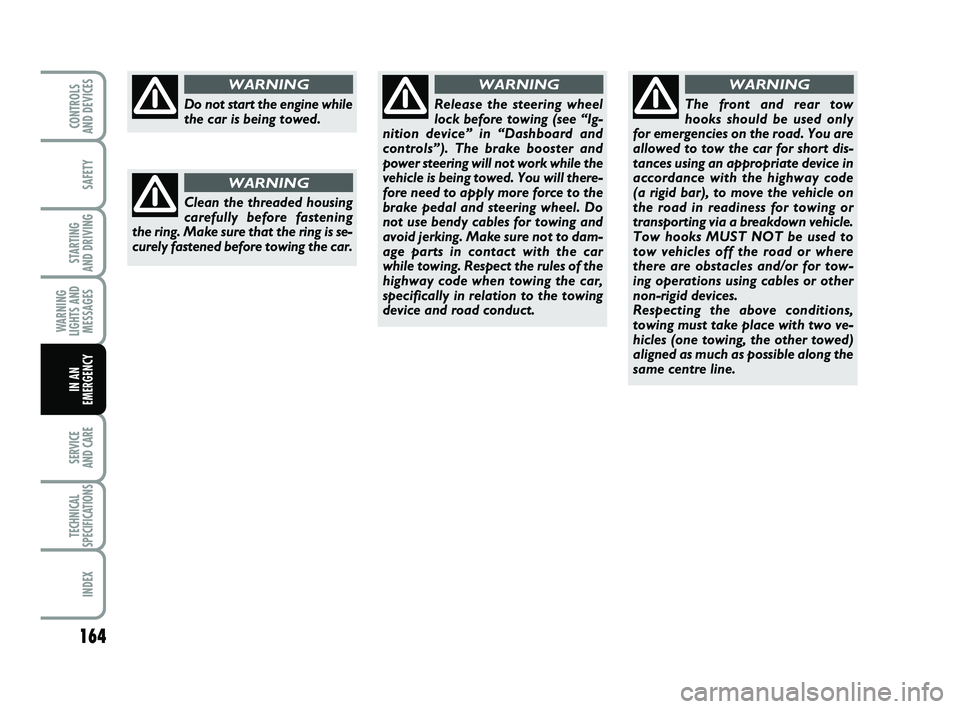
164
SAFETY
STARTING
AND DRIVING
WARNING
LIGHTS AND MESSAGES
SERVICE
AND CARE
TECHNICAL
SPECIFICATIONS
INDEX
CONTROLS
AND DEVICES
IN AN
EMERGENCY
Do not start the engine while
the car is being towed.
WARNING
Clean the threaded housing
carefully before fastening
the ring. Make sure that the ring is se-
curely fastened before towing the car.
WARNING
Release the steering wheel
lock before towing (see “Ig-
nition device” in “Dashboard and
controls”). The brake booster and
power steering will not work while the
vehicle is being towed. You will there-
fore need to apply more force to the
brake pedal and steering wheel. Do
not use bendy cables for towing and
avoid jerking. Make sure not to dam-
age parts in contact with the car
while towing. Respect the rules of the
highway code when towing the car,
specifically in relation to the towing
device and road conduct.
WARNING
The front and rear tow
hooks should be used only
for emergencies on the road. You are
allowed to tow the car for short dis-
tances using an appropriate device in
accordance with the highway code
(a rigid bar), to move the vehicle on
the road in readiness for towing or
transporting via a breakdown vehicle.
Tow hooks MUST NOT be used to
tow vehicles off the road or where
there are obstacles and/or for tow-
ing operations using cables or other
non-rigid devices.
Respecting the above conditions,
towing must take place with two ve-
hicles (one towing, the other towed)
aligned as much as possible along the
same centre line.
WARNING
133-164 PUNTO POP 1ed EN 30-09-2011 10:20 Pagina 164
Page 170 of 219
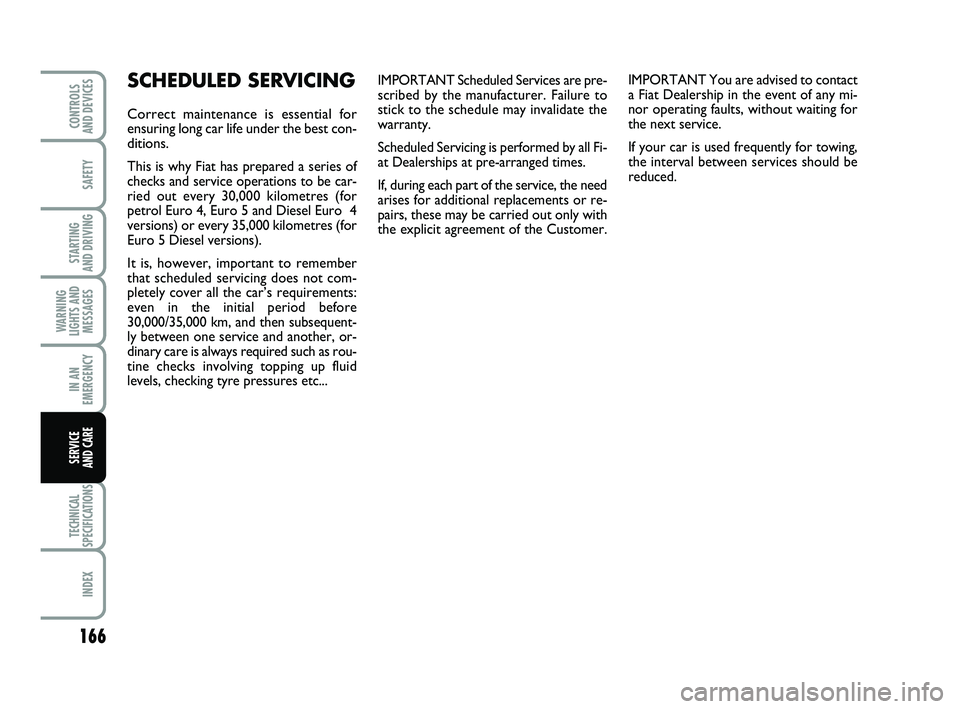
166
SAFETY
STARTING
AND DRIVING
WARNING
LIGHTS AND MESSAGES
IN AN
EMERGENCY
TECHNICAL
SPECIFICATIONS
INDEX
CONTROLS
AND DEVICES
SERVICE
AND CARE
IMPORTANT Scheduled Services are pre-
scribed by the manufacturer. Failure to
stick to the schedule may invalidate the
warranty.
Scheduled Servicing is performed by all Fi-
at Dealerships at pre-arranged times.
If, during each part of the service, the need
arises for additional replacements or re-
pairs, these may be carried out only with
the explicit agreement of the Customer. IMPORTANT You are advised to contact
a Fiat Dealership in the event of any mi-
nor operating faults, without waiting for
the next service.
If your car is used frequently for towing,
the interval between services should be
reduced.SCHEDULED SERVICING
Correct maintenance is essential for
ensuring long car life under the best con-
ditions.
This is why Fiat has prepared a series of
checks and service operations to be car-
ried out every 30,000 kilometres (for
petrol Euro 4, Euro 5 and Diesel Euro 4
versions) or every 35,000 kilometres (for
Euro 5 Diesel versions).
It is, however, important to remember
that scheduled servicing does not com-
pletely cover all the car’s requirements:
even in the initial period before
30,000/35,000 km, and then subsequent-
ly between one service and another, or-
dinary care is always required such as rou-
tine checks involving topping up fluid
levels, checking tyre pressures etc...
165-184 PUNTO POP 1ed EN 30-09-2011 10:21 Pagina 166
Page 172 of 219
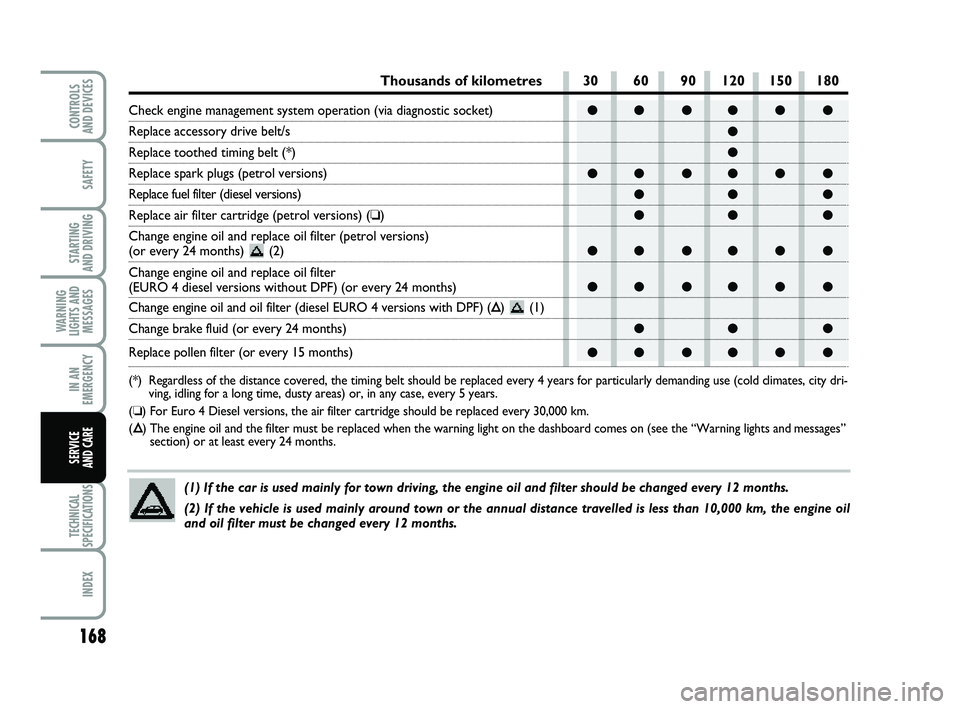
168
SAFETY
STARTING
AND DRIVING
WARNING
LIGHTS AND MESSAGES
IN AN
EMERGENCY
TECHNICAL
SPECIFICATIONS
INDEX
CONTROLS
AND DEVICES
SERVICE
AND CARE
●● ●● ● ●
●
●
●● ●● ● ●
●● ●
●● ●
●● ●● ● ●
●● ●● ● ●
●● ●
●● ●● ● ●
Thousands of kilometres 30 60 90 120 150 180
Check engine management system operation (via diagnostic socket)
Replace accessory drive belt/s
Replace toothed timing belt (*)
Replace spark plugs (petrol versions)
Replace fuel filter (diesel versions)
Replace air filter cartridge (petrol versions) (❏)
Change engine oil and replace oil filter (petrol versions)
(or every 24 months) (2)
Change engine oil and replace oil filter
(EURO 4 diesel versions without DPF) (or every 24 months)
Change engine oil and oil filter (diesel EURO 4 versions with DPF) (Õ) (1)
Change brake fluid (or every 24 months)
Replace pollen filter (or every 15 months)
(*) Regardless of the distance covered, the timing belt should be replaced e\
very 4 years for particularly demanding use (cold c limates, city dri-
ving, idling for a long time, dusty areas) or, in any case, every 5 yea\
rs.
( ❏ ) For Euro 4 Diesel versions, the air filter cartridge should be replac\
ed every 30,000 km.
( Õ ) The engine oil and the filter must be replaced when the warning light on\
the dashboard comes on (see the “Warning lights and messages”
section) or at least every 24 months.
(1) If the car is used mainly for town driving, the engine oil and fil\
ter should be changed every 12 months.
(2) If the vehicle is used mainly around town or the annual distance t\
ravelled is less than 10,000 km, the engine oil
and oil filter must be changed every 12 months.
165-184 PUNTO POP 1ed EN 30-09-2011 10:21 Pagina 168
Page 174 of 219
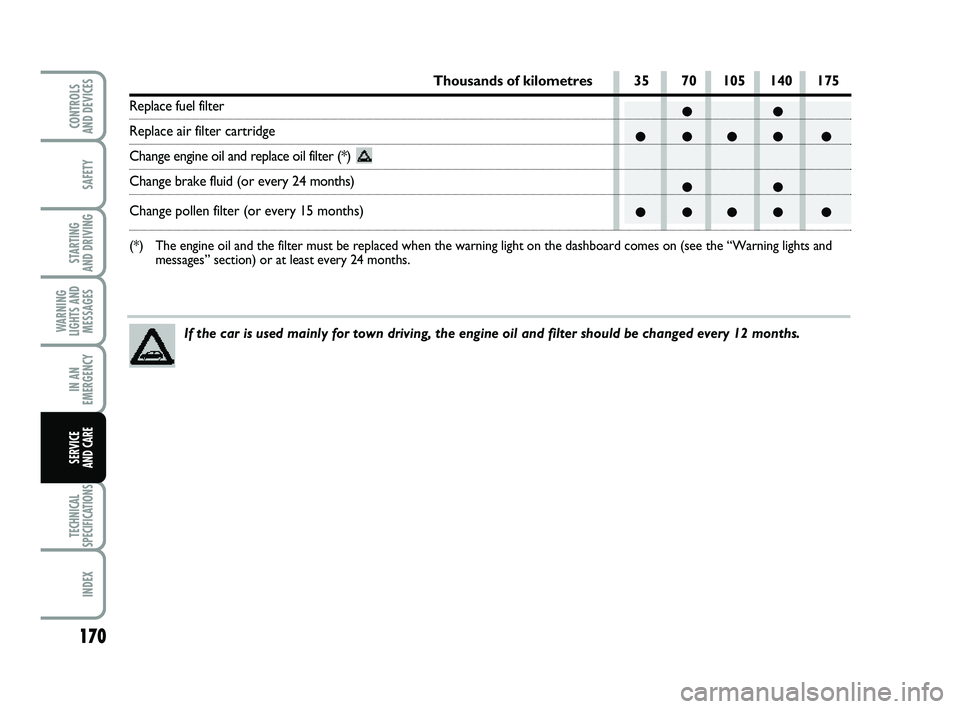
170
SAFETY
STARTING
AND DRIVING
WARNING
LIGHTS AND MESSAGES
IN AN
EMERGENCY
TECHNICAL
SPECIFICATIONS
INDEX
CONTROLS
AND DEVICES
SERVICE
AND CARE
●●
●●●● ●
●●
●●●● ●
Thousands of kilometres 35 70 105 140 175
Replace fuel filter
Replace air filter cartridge
Change engine oil and replace oil filter (*)
Change brake fluid (or every 24 months)
Change pollen filter (or every 15 months)
(*) The engine oil and the filter must be replaced when the warning light on\
the dashboard comes on (see the “Warning lights and messages” section) or at least every 24 months.
If the car is used mainly for town driving, the engine oil and filter sh\
ould be changed every 12 months.
165-184 PUNTO POP 1ed EN 30-09-2011 10:21 Pagina 170
Page 175 of 219
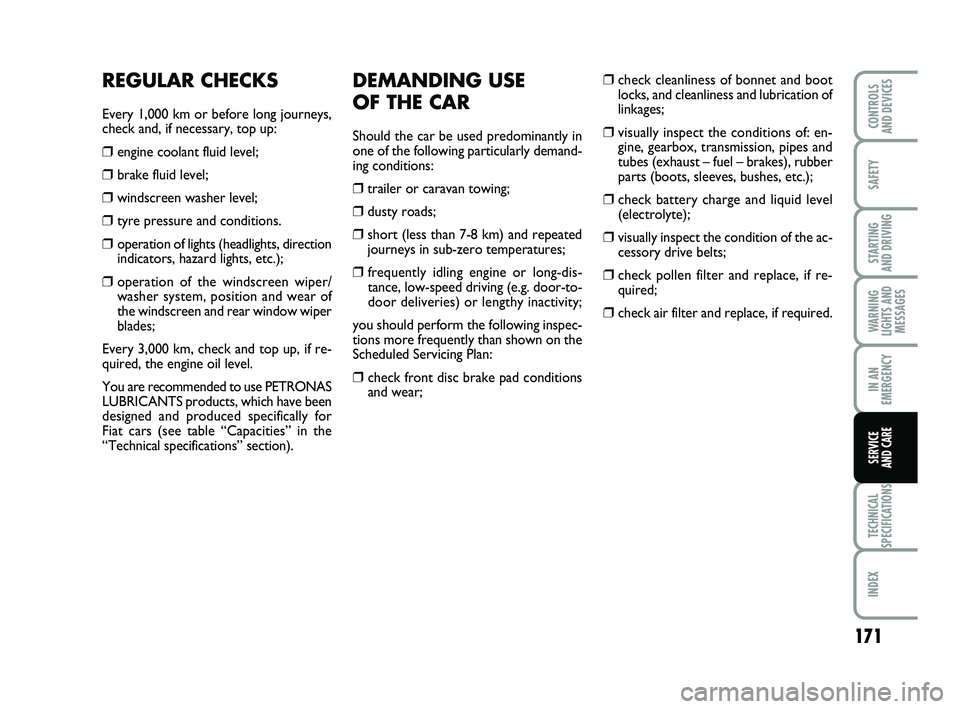
171
SAFETY
STARTING
AND DRIVING
WARNING
LIGHTS AND MESSAGES
IN AN
EMERGENCY
TECHNICAL
SPECIFICATIONS
INDEX
CONTROLS
AND DEVICES
SERVICE
AND CARE
DEMANDING USE
OF THE CAR
Should the car be used predominantly in
one of the following particularly demand-
ing conditions:
❒trailer or caravan towing;
❒dusty roads;
❒short (less than 7-8 km) and repeated
journeys in sub-zero temperatures;
❒ frequently idling engine or long-dis-
tance, low-speed driving (e.g. door-to-
door deliveries) or lengthy inactivity;
you should perform the following inspec-
tions more frequently than shown on the
Scheduled Servicing Plan:
❒ check front disc brake pad conditions
and wear;
❒check cleanliness of bonnet and boot
locks, and cleanliness and lubrication of
linkages;
❒ visually inspect the conditions of: en-
gine, gearbox, transmission, pipes and
tubes (exhaust – fuel – brakes), rubber
parts (boots, sleeves, bushes, etc.);
❒check battery charge and liquid level
(electrolyte);
❒visually inspect the condition of the ac-
cessory drive belts;
❒check pollen filter and replace, if re-
quired;
❒check air filter and replace, if required.
REGULAR CHECKS
Every 1,000 km or before long journeys,
check and, if necessary, top up:
❒engine coolant fluid level;
❒brake fluid level;
❒windscreen washer level;
❒tyre pressure and conditions.
❒operation of lights (headlights, direction
indicators, hazard lights, etc.);
❒operation of the windscreen wiper/
washer system, position and wear of
the windscreen and rear window wiper
blades;
Every 3,000 km, check and top up, if re-
quired, the engine oil level.
You are recommended to use PETRONAS
LUBRICANTS products, which have been
designed and produced specifically for
Fiat cars (see table “Capacities” in the
“Technical specifications” section).
165-184 PUNTO POP 1ed EN 30-09-2011 10:21 Pagina 171
Page 201 of 219
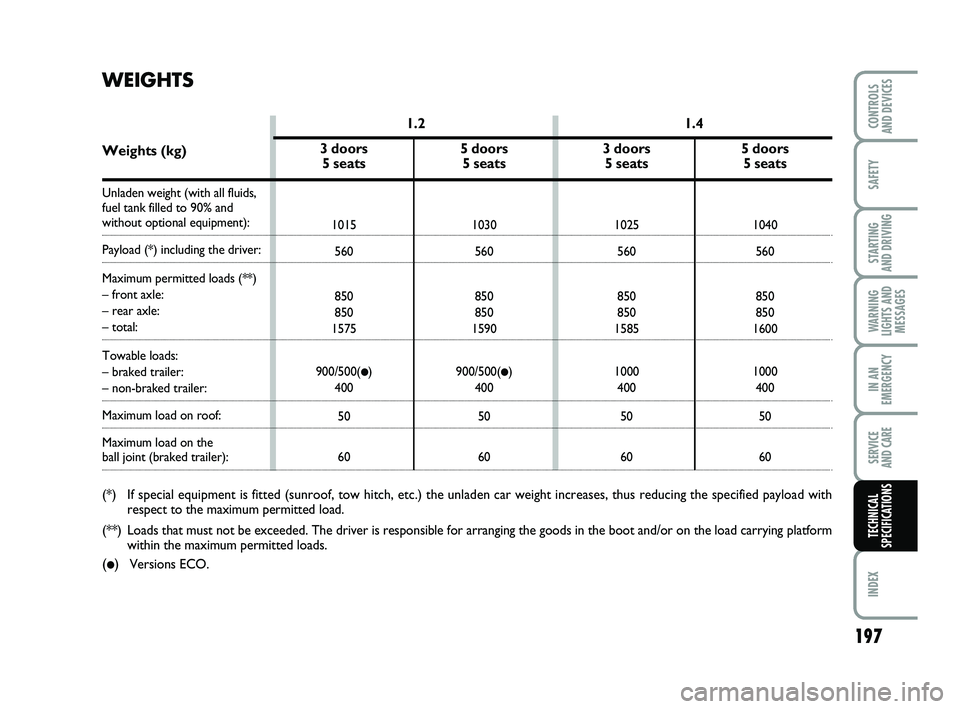
5 doors5 seats
1030
560
850
850
1590
900/500(
●)
400
50
60
3 doors 5 seats
1025
560
850
850
1585
1000 400
50
60
5 doors 5 seats
1040
560
850
850
1600
1000 400
50
60
197
SAFETY
STARTING
AND DRIVING
WARNING
LIGHTS AND MESSAGES
IN AN
EMERGENCY
SERVICE
AND CARE
INDEX
CONTROLS
AND DEVICES
TECHNICAL
SPECIFICATIONS
WEIGHTS
1.2 1.4
Weights (kg)
Unladen weight (with all fluids,
fuel tank filled to 90% and
without optional equipment):
Payload (*) including the driver:
Maximum permitted loads (**)
– front axle:
– rear axle:
– total:
Towable loads:
– braked trailer:
– non-braked trailer:
Maximum load on roof:
Maximum load on the
ball joint (braked trailer):
(*) If special equipment is fitted (sunroof, tow hitch, etc.) the unladen \
car weight increases, thus reducing the specified payload with respect to the maximum permitted load.
(**) Loads that must not be exceeded. The driver is responsible for arranging\
the goods in the boot and/or on the load carrying platform
within the maximum permitted loads.
(●)Versions ECO.
3 doors 5 seats
1015
560
850
850
1575
900/500(
●)
400
50
60
185-208 PUNTO POP 1ed EN 3-10-2011 11:50 Pagina 197
Page 202 of 219
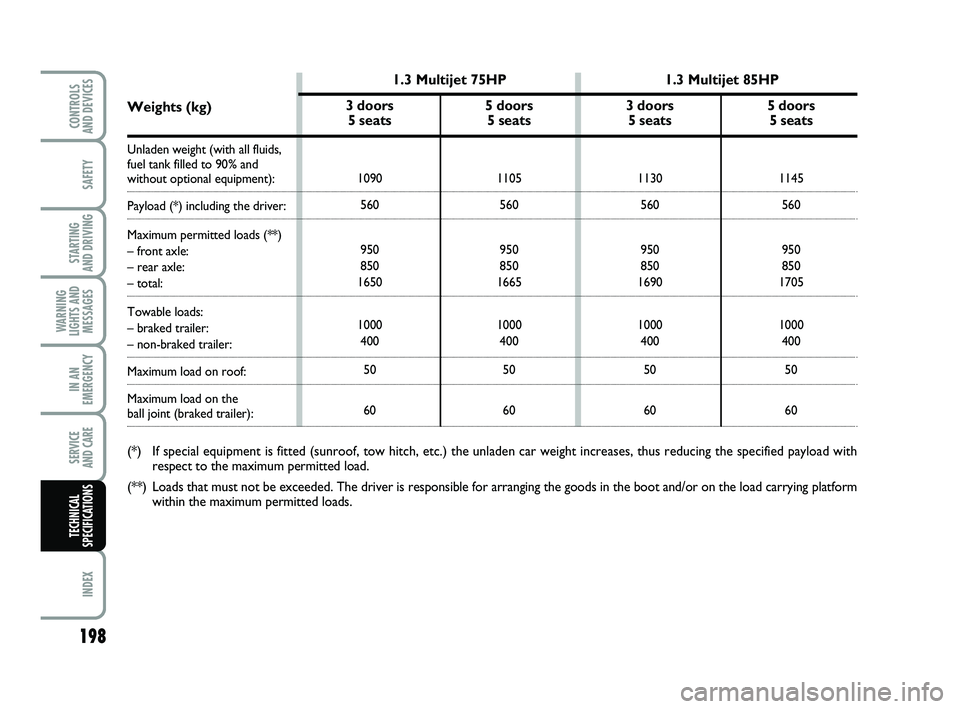
198
SAFETY
STARTING
AND DRIVING
WARNING
LIGHTS AND MESSAGES
IN AN
EMERGENCY
SERVICE
AND CARE
INDEX
CONTROLS
AND DEVICES
TECHNICAL
SPECIFICATIONS
3 doors 5 seats
1090
560
950
850
1650
1000 400
50
60
5 doors 5 seats
1105
560
950
850
1665
1000 400
50
60
3 doors 5 seats
1130
560
950
850
1690
1000 400
50
60
5 doors 5 seats
1145
560
950
850
1705
1000 400
50
60
1.3 Multijet 75HP 1.3 Multijet 85HP
Weights (kg)
Unladen weight (with all fluids,
fuel tank filled to 90% and
without optional equipment):
Payload (*) including the driver:
Maximum permitted loads (**)
– front axle:
– rear axle:
– total:
Towable loads:
– braked trailer:
– non-braked trailer:
Maximum load on roof:
Maximum load on the
ball joint (braked trailer):
(*) If special equipment is fitted (sunroof, tow hitch, etc.) the unladen \
car weight increases, thus reducing the specified payload with respect to the maximum permitted load.
(**) Loads that must not be exceeded. The driver is responsible for arranging\
the goods in the boot and/or on the load carrying platform
within the maximum permitted loads.
185-208 PUNTO POP 1ed EN 3-10-2011 11:50 Pagina 198
Page 206 of 219
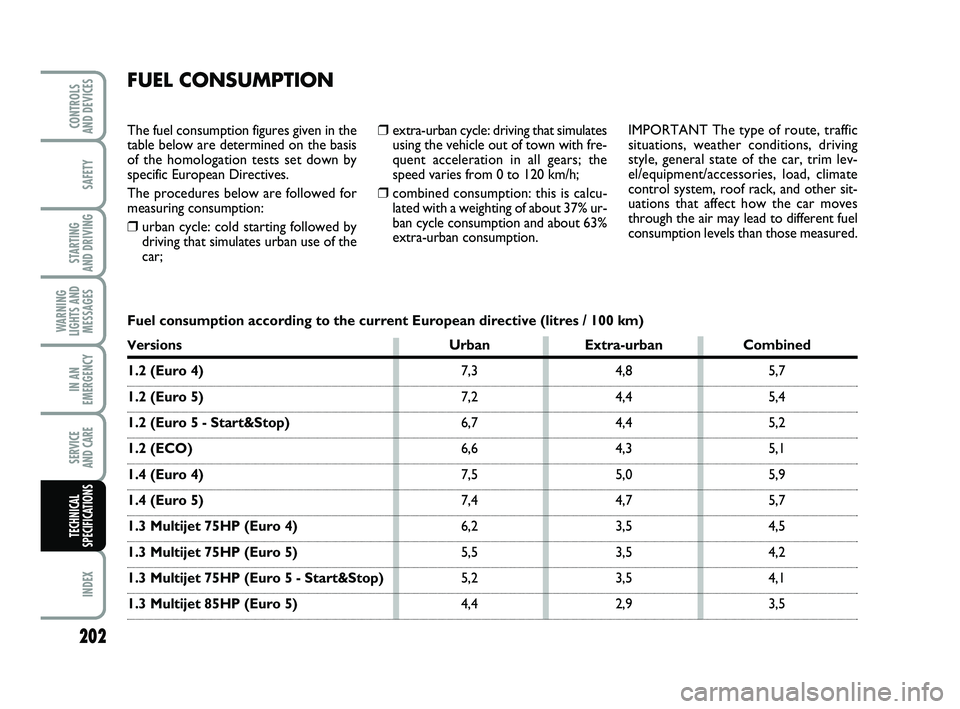
202
SAFETY
STARTING
AND DRIVING
WARNING
LIGHTS AND MESSAGES
IN AN
EMERGENCY
SERVICE
AND CARE
INDEX
CONTROLS
AND DEVICES
TECHNICAL
SPECIFICATIONS
❒extra-urban cycle: driving that simulates
using the vehicle out of town with fre-
quent acceleration in all gears; the
speed varies from 0 to 120 km/h;
❒combined consumption: this is calcu-
lated with a weighting of about 37% ur-
ban cycle consumption and about 63%
extra-urban consumption.
The fuel consumption figures given in the
table below are determined on the basis
of the homologation tests set down by
specific European Directives.
The procedures below are followed for
measuring consumption:
❒urban cycle: cold starting followed by
driving that simulates urban use of the
car; IMPORTANT The type of route, traffic
situations, weather conditions, driving
style, general state of the car, trim lev-
el/equipment/accessories, load, climate
control system, roof rack, and other sit-
uations that affect how the car moves
through the air may lead to different fuel
consumption levels than those measured.
Fuel consumption according to the current European directive (litres / \
100 km)
Versions UrbanExtra-urban Combined
1.2 (Euro 4) 7,3 4,8 5,7
1.2 (Euro 5)7,2 4,4 5,4
1.2 (Euro 5 - Start&Stop)6,7 4,4 5,2
1.2 (ECO)6,6 4,3 5,1
1.4 (Euro 4)7,5 5,0 5,9
1.4 (Euro 5)7,4 4,7 5,7
1.3 Multijet 75HP (Euro 4)6,2 3,5 4,5
1.3 Multijet 75HP (Euro 5)5,5 3,5 4,2
1.3 Multijet 75HP (Euro 5 - Start&Stop)5,2 3,5 4,1
1.3 Multijet 85HP (Euro 5)4,4 2,9 3,5
FUEL CONSUMPTION
185-208 PUNTO POP 1ed EN 3-10-2011 11:50 Pagina 202
Page 214 of 219
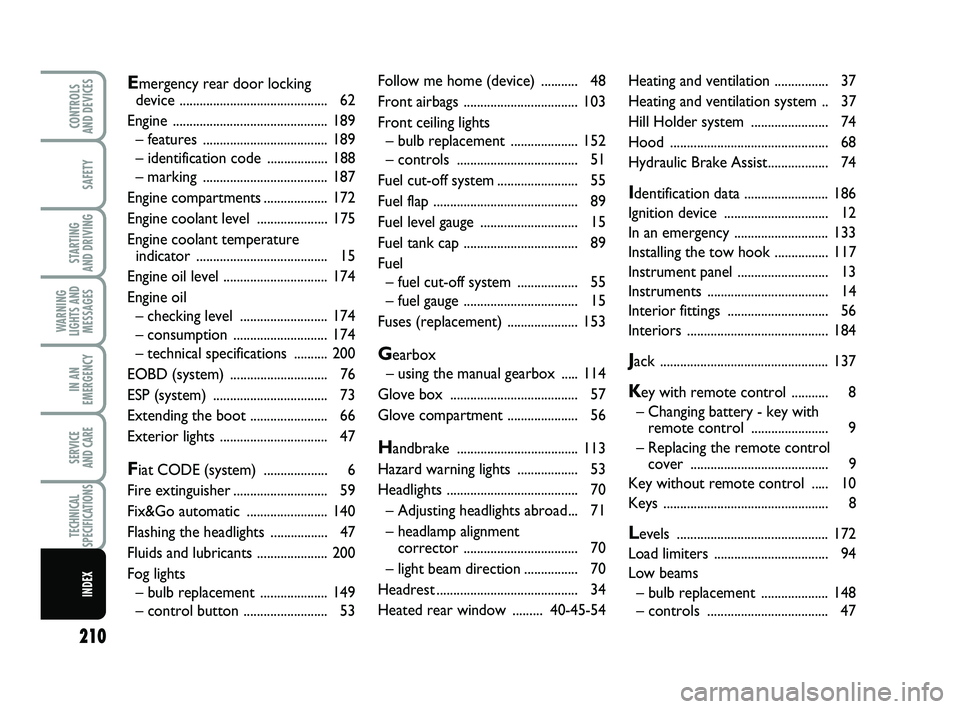
210
SAFETY
STARTING
AND DRIVING
WARNING
LIGHTS AND MESSAGES
IN AN
EMERGENCY
SERVICE
AND CARE
TECHNICAL
SPECIFICATIONS
INDEX
CONTROLS
AND DEVICES
Follow me home (device) ........... 48
Front a irbags .................................. 103
Front ceiling lights – bulb replace ment .................... 152
– controls .................................... 51
Fuel cut-off system........................ 55
Fuel flap ........................................... 89
Fuel level gauge ............................. 15
Fuel tank cap .................................. 89
Fuel – fuel cut-off system .................. 55
– fuel gauge .................................. 15
Fuses (replacement) ..................... 153
Gearbox
– using the manual gearbox ..... 114
Glove bo x ...................................... 57
Glove compart ment ..................... 56
Handbrake .................................... 113
Hazard warning lights .................. 53
Headlights ....................................... 70
– Adjusting headlights abroad... 71
– headlamp alignment corrector .................................. 70
– light beam direction ................ 70
Headrest .......................................... 34
Heated rear win dow ......... 40-45-54 Heating and vent
ilation ................ 37
Heating and ventilation system .. 37
Hill Holder system ....................... 74
Hood ............................................... 68
Hydraulic Brake Assist .................. 74
Identification data ......................... 186
Ignition device ............................... 12
In an emer gency ............................ 133
Installing the tow hook ................ 117
Instrument panel ........................... 13
Instruments .................................... 14
Interior fittings .............................. 56
Interiors .......................................... 184
Jack .................................................. 137
Key with remote control ........... 8
– Changing battery - key with remote control ....................... 9
– Replacing the remote control cover ......................................... 9
Key without rem ote control ..... 10
Keys ................................................. 8
Levels ............................................. 172
Load limiters .................................. 94
Low beams – bulb replace ment .................... 148
– controls .................................... 47
Emergency rear door locking
device ............................................ 62
Engine .............................................. 189
– features ..................................... 189
– identification c ode ..................188
– marking ..................................... 187
Engine compart ments................... 172
Engine coolan t level ..................... 175
Engine coolant temperature indicator ....................................... 15
Engine oil level ............................... 174
Engine oil – checking level .......................... 174
– consumpt ion ............................ 174
– technical specifications .......... 200
EOBD (system) ............................. 76
ESP (system) .................................. 73
Extending th e boot ....................... 66
Exterior lights ................................ 47
Fiat CODE (system) ................... 6
Fire exting uisher............................ 59
Fix&Go autom atic ........................ 140
Flashing the h eadlights ................. 47
Fluids and lubricants ..................... 200
Fog lights – bulb replace ment .................... 149
– control button ......................... 53
209-214 PUNTO POP 1ed EN 3-10-2011 11:53 Pagina 210